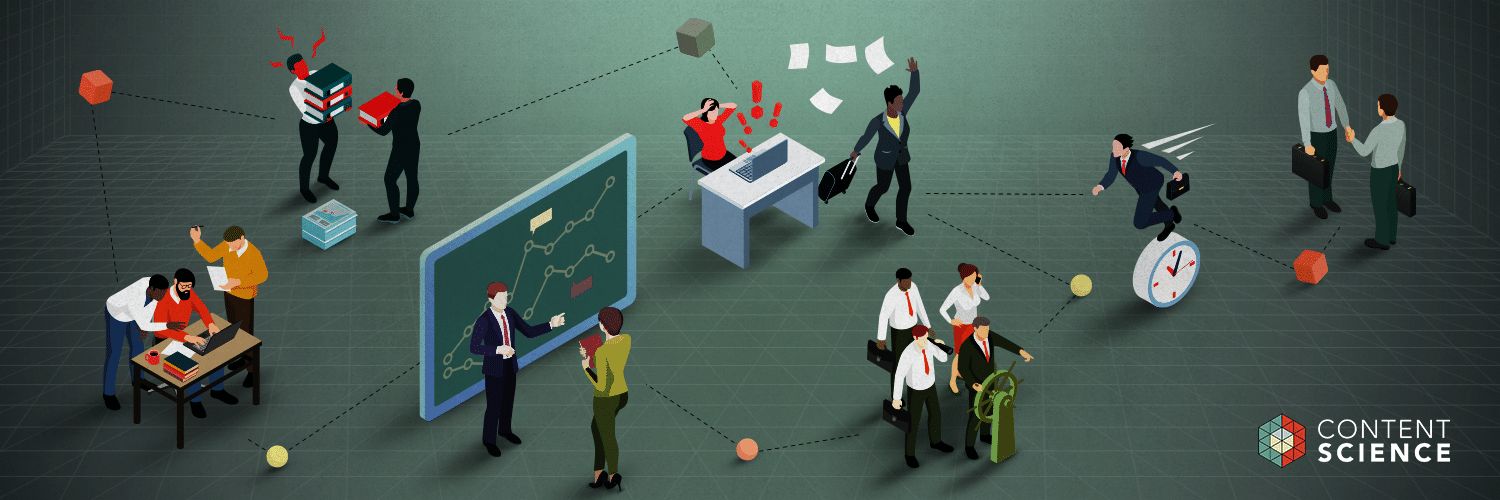
How many times do you have a great idea for a piece, only to have your colleague poke holes in it? How often do you try to explain your point of view, but end up feeling unheard? How frequently is co-creation a source of frustration, rather than a source of inspiration?
Having multiple voices in the creative process can deliver exceptional content. Yet, when collaboration goes sideways, it can strain your relationships and cause immense stress.
Whether you’re working for a scatter-brained manager, collaborating with an opinionated colleague, or trying to capture the thinking of a subject matter expert, being able to navigate the nuance of co-creation is imperative. As a content leader, it’s up to you to bring out the best of all parties in the co-creation process, even if you’re not the person who is formally in charge.
Through co-creation, there are inevitable disagreements. Creative expressions are vulnerable, the work can be highly personal, and feedback is generally a matter of personal opinion—versus an obvious bug in code or a miscalculation on a spreadsheet.
It’s tempting to view consensus (universal agreement) as the ultimate goal in co-creation. When everyone is seemingly aligned, things generally feel better, on the surface.
Unfortunately, full consensus, especially if reached too quickly, often results in undifferentiated ideas, stifled voices, and mediocre results. Channeling your energy toward effective collaboration (knowing that full consensus may never be reached) ultimately creates better content. This means that instead of pushing for agreement, you push for ideas. Instead of nodding along, you ask questions. Instead of getting frustrated with different opinions, you explore them.
Collaboration requires that you (and everyone else) navigate the space between rolling over and agreeing to everything and being a stubborn fuss who always demands things go their way.
You have ideas, expertise, and value to provide. You may also be working for an organization with certain constraints or for a boss who gets the final word. Still, you’re never powerless. You can shape the collaboration process from whatever seat you’re in.
Here’s how:
1. Don’t Wait to Co-Create
When you’re eager to make a good impression, it’s tempting to bring (what you deem) finished products to the co-creation conversation. Especially if the co-creation conversation is with your boss or another senior leader in the organization. This is setting yourself and your collaboration partners up for failure. Here’s what happens when you show up with something “done” :
- Your collaborators don’t see room for themselves in the work. This prompts them to either be upset that they were left out or to disengage, neither of which is good for you.
- You’re too attached to everything exactly as it is. The more time marches on, the more intellectual horsepower you spend refining, the less open you’re going to be to feedback and new ideas.
While on the surface, the possibility of your collaborator disengaging or providing no feedback may seem like a tempting outcome, this only erodes your organizational goodwill in the long term. It can also cause you to miss out on potential insights.
2. Set the Stage
Showing up to a co-creation conversation with a metaphoric blank page rarely results in valuable content. Even if you’re not formally in charge, you can set the stage for effective collaboration by establishing the context. These are parameters like:
- Where will this content be going?
- What is the intent?
- How much time do you have? Or not have?
- Who owns which elements?
- How will you measure success?
Even if you don’t know the answers, ask the questions. At first blush, these tactical elements might seem like creativity killers. The opposite is true. When the context is defined at the start, it enables everyone in the conversation to engage effectively. You reduce the amount of mental popup windows, assumptions, or concerns that erode effective collaboration. You also position yourself as a strategic leader, formal or not.
3. Leverage the Strengths of Your Collaborators
Knowing someone’s strengths enables you to leverage those strengths most effectively. That might read a little manipulative; it’s not intended to be. People deserve to have their expertise valued. They should be asked to contribute where their brain can be most useful.
For example, let’s say your colleague has an exceptional eye for detail. Asking for their feedback in the brainstorming stages is probably going to be a frustrating experience for you both. They’re going to be wondering why your color palette isn’t on-brand and you’re going to be wondering why they can’t be free-thinking this early in the process. Your colleague feels like you aren’t valuing their advice (they’re right) and you feel like your colleague isn’t supporting you in development (you’re right).
4. Look for the Feedback Behind the Feedback
Sometimes feedback givers don’t really know the ‘why’ behind their feedback. You’ve probably watched a film, walked through a model home, or read a report that was off somehow. You didn’t know why, but you knew it was off. The people collaborating with you are likely the same; they may be giving you a first reaction without knowing why they feel that way.
Ideally, the feedback-giver has contextualized their remarks and walked you through what led them to that conclusion. In the event they don’t (they probably won’t), you can uncover the feedback behind the feedback by asking questions like:
- What prompted that thinking?
- Why do you think that jumped out at you?
- Do you think that’s emblematic of this project/idea/problem?
- How can I build on that?
- How can I resolve that?
- In your eyes, what should change?
- What would happen if I changed that?
- Have you had a similar experience/worked on a similar project that went differently?
This isn’t an interrogation or an attempt to invalidate the feedback. You’re genuinely curious: What’s behind this? Is it deeper than the initial feedback suggests?
5. Explain Your Train of Thought
You’ve likely been on the receiving end of frustratingly baseless “feedback” during the collaboration process. Make sure your colleagues don’t have that experience when they’re getting feedback from you.
Ordering here matters. Usually, we start with the punchline of our feedback, like “This isn’t creative enough.” Then, we walk through all the reasons why we think it’s not creative enough.
But, while we’re explaining our rationale, the person we’re giving feedback to is emotionally strewing (and therefore, not listening). Instead of hearing you out, this person is likely coming up with a mental list of why your feedback is wrong.
Instead, start with what prompted your thinking. This might be something like, “In thinking about the campaigns our competitors have launched in the last 12 months, I’m worried this isn’t as differentiated as you want it to be.”
It seems counterintuitive but explaining your thought process before you deliver your “punch line” shows your feedback is coming with good intent. You’re still saying the idea is not creative enough. But, because you’ve explained your train of thought, this other person will (probably) be less defensive. They see that you’re not taking cheap shots; you’re really trying to help.
6. Disagree and Commit
There comes a time when collaboration ends, and the decision is made.
Sometimes, your boss, department leader, or CEO makes a decision that you disagree with. It could be because the decision maker had more expertise, it could be that it’s the right decision for the company (even if it makes your job harder), or it could be that it was a bad decision because the leaders don’t have the depth of understanding you do.
Whatever the case, to keep your job (and your sanity) you need to commit anyway.
The disagree and commit practice originates from Amazon. Here’s how Amazon describes it:
Leaders are obligated to respectfully challenge decisions when they disagree, even when doing so is uncomfortable or exhausting. Leaders have conviction and are tenacious. They do not compromise for the sake of social cohesion. Once a decision is determined, they commit wholly.
We’ve all seen instances where someone disagrees and then doesn’t commit, hoping that once the decision fails everyone will see that they were right all along. But holding your breath to be proven right certainly doesn’t serve your organization, and more importantly, it doesn’t serve you. It keeps you emotionally on guard and reluctant to lean in. Ultimately, you’ll either be:
- Wrong, and have wasted a lot of mental energy and invested a lot of emotion digging your heels into the sand.
- Right …now what? Your organization made a bad call, is in a tough spot, and everyone is remorseful. Do you think you’re going to get a personal apology from the CEO? Probably not. And even if you do get recognized for being right, saying “I told you so!” to people you at least partially care about doesn’t feel good.
In many cases, you’ll never even know whether the decision you wanted would have been better than what was chosen. Most business decisions don’t fall neatly into a cut-and-dry category of ‘amazing’ or ‘terrible.’ The majority are somewhere in the murky middle, and there are often unexpected consequences no matter what path you choose.
You’re better off stating your recommendations in the collaboration phase, and then committing to support your team when it’s time to implement, whether you would have chosen that direction or not.
Collaboration and consensus are not the same. You can be a great collaborator and ultimately disagree with the outcome. That doesn’t mean the collaboration wasn’t worth it.
Harnessing the best thinking of your colleagues during the collaboration process, and bringing your best thinking to the table, serves all parties. Even through frustrating moments, collaboration sets the stage for innovative thinking, big ideas, and breakthrough content.
Even if it doesn’t always end the way you wanted.
Events, Resources, + More
The Ultimate Guide to End-to-End Content
Discover why + how an end-to-end approach is critical in the age of AI with this comprehensive white paper.
The Content Advantage Book
The much-anticipated third edition of the highly rated book by Colleen Jones is available at book retailers worldwide. Learn more!
20 Signs of a Content Problem in a High-Stakes Initiative
Use this white paper to diagnose the problem so you can achieve the right solution faster.
Upskill with Content Science Academy
Training for modern content roles through on-demand certifications + courses or live workshops.






Comments
We invite you to share your perspective in a constructive way. To comment, please sign in or register. Our moderating team will review all comments and may edit them for clarity. Our team also may delete comments that are off-topic or disrespectful. All postings become the property of
Content Science Review.